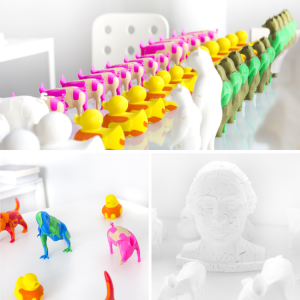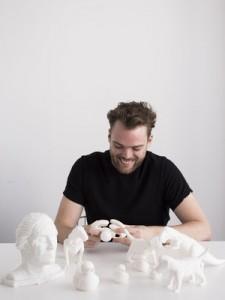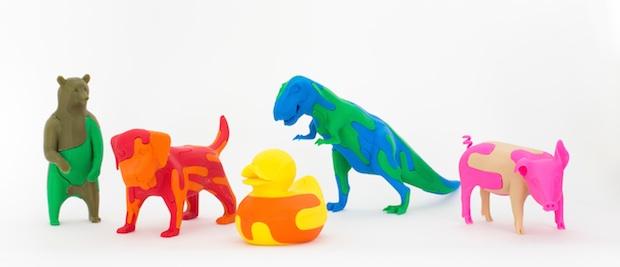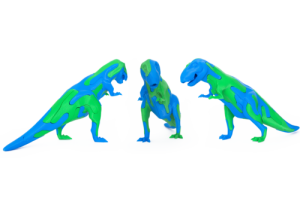Brooklyn designer Fleet Hower has combined a longtime fascination with puzzles with his professional interest in bringing together digital design, physical production, and the latest in technology. The natural brainchild of this union is a 3D puzzle, and working with 3D Hubs, Hower has designed six 3D puzzles that are available today.
“I’ve always been fascinated with jigsaw puzzles and the geometries that make up their connections, but wished they could be designed with more freedom in three dimensions,” Hower said.
Hower’s puzzle dreams have started to become reality: he developed his Lock-Nesters puzzles on a desktop 3D printer. While he selected this method for its speed and relative ease, the process was not without its hiccups.
“My first prototype did not hold together at all, and the second would not come apart,” Hower explained. “It was only after a few hundred iterations of testing that I began to develop an intuition about what would make a successful connection.”
 Once the kinks were worked out, 3D desktop printing was the best method for such an undertaking because the puzzle pieces could be designed to connect on the sides and in the middle, creating fully interlocking objects. Also, with 3D printing, once set, a design is consistent through each batch of prints.
Once the kinks were worked out, 3D desktop printing was the best method for such an undertaking because the puzzle pieces could be designed to connect on the sides and in the middle, creating fully interlocking objects. Also, with 3D printing, once set, a design is consistent through each batch of prints.
“Conventional methods such as injection molding and casting came with quotes that were prohibitively high, but it makes no difference to a 3D printer whether each piece is the same or different, so we are leveraging 3D printing by using unique pieces that could not be produced another way,” explained Hower.
To create and sell the puzzles, Hower teamed up with 3D Hubs, a network of more than 8,000 3D printers in 140 countries. The “hubs” of 3D Hubs are people who own 3D printers and will print up projects. Customers can search for a printer near them using their desired materials and colors, among other considerations.
FDM 3D printer methods use support structures for printed pieces with geometric undercuts or horizontal expanse. When a Lock-Nester arrives at your door, it will still be attached to its supports. These are easily removed, and a quick once over with the included sandpaper will ensure smooth edges.
The inaugural collection of Lock-Nesters includes five ready-to-order puzzles with 5 to 27 pieces. A sixth puzzle will be released in the near future and contains a whopping 185 interlocking pieces.
Currently available are a bear (Albert), a pig (Monica), and a duck (Suima)–all available in two sizes–and a larger T-Rex (Heiner) and dog (Otis), available in one size. They vary in complexity, with Albert being a fairly simple model to put together and Otis a more challenging puzzle with pieces that ‘vary considerably in terms of size and complexity.’
George, the yet-to-come puzzle, is a nearly 200-piece 3D bust of George Washington.
If you want your very own Lock-Nester, you can order in one of two ways: through Hower’s website (where you’ll receive the colors as shown), or via 3D Hubs, where you choose your Lock-Nester certified hub and pick your own colors from the hub’s availability.
Puzzles start at $15 (for the mini versions of Albert, Monica, and Suima) and go up to $36 for Heiner and Otis. George, which is not yet available, has an impressive 185 pieces and will be priced at a more premium level.
Now that these puzzles are available, Hower has plans to create even more complex and customizable puzzles. While 3D Hub does offer custom color choices, Hower hopes in the future to offer custom puzzle forms, potentially even expanding to offer the ability to create a unique, personal puzzle.
“All of our work is driven by algorithms,” he explains, “so there is a lot of digital modeling and code writing that goes on in the office. We’re hoping to increase the customer’s ability to act as a client and influence the design of the end product.”
Inspired by the design of his “George” bust, these custom offerings might include a bust of…you!
“Everyone is important enough to be immortalized by a puzzle bust,” says Hower.
Subscribe to Our Email Newsletter
Stay up-to-date on all the latest news from the 3D printing industry and receive information and offers from third party vendors.
Print Services
Upload your 3D Models and get them printed quickly and efficiently.
You May Also Like
The Dental Additive Manufacturing Market Could Nearly Double by 2033, According to AM Research
According to an AM Research report from 2024, the medical device industry, specifically in dentistry, prosthetics, and audiology, is expected to see significant growth as these segments continue to benefit from...
Heating Up: 3D Systems’ Scott Green Discusses 3D Printing’s Potential in the Data Center Industry
The relentless rise of NVIDIA, the steadily increasing pledges of major private and public investments in national infrastructure projects around the world, and the general cultural obsession with AI have...
AM Research Webinar Explores Continuum’s Sustainable Metal Additive Manufacturing Powders
Metal additive manufacturing (AM) powder supplier Continuum Powders is working to develop solutions that empower industries to reduce waste and optimize their resources. An independent life cycle assessment (LCA) of...
3D Printed Footwear Startup Koobz Lands $7.2M in Seed Round
California-based Koobz is focused on reshoring the U.S. footwear supply chain with advanced manufacturing processes, including 3D printing. The startup just announced that it has added $6 million to its...





































